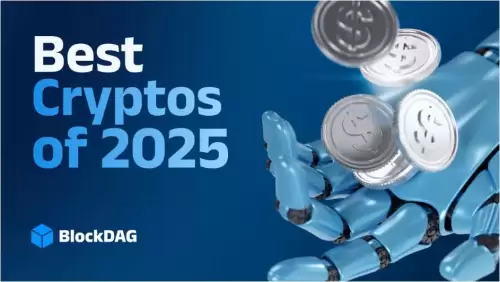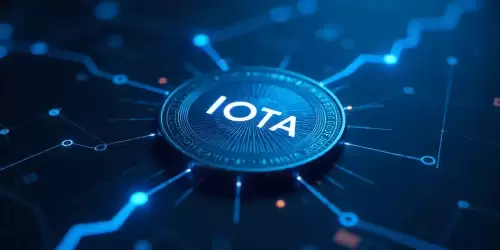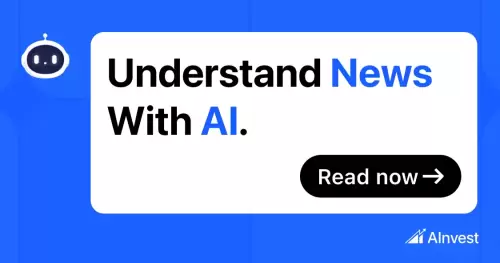 |
|
 |
|
 |
|
 |
|
 |
|
 |
|
 |
|
 |
|
 |
|
 |
|
 |
|
 |
|
 |
|
 |
|
 |
|
Nachrichtenartikel zu Kryptowährungen
Leemon Baird, the Inventor of Hashgraph, Explains How It Works as an Alternative to Blockchain Architectures
May 13, 2025 at 01:06 am

Leemon Baird, co-founder of Hedera Hashgraph, is no stranger to the world of technology. With a background in computer science and a career spanning both academia and industry, Baird is uniquely positioned to provide insights into the promise and potential of blockchain technology.
In a recent interview with CoinDesk, Baird discussed his journey developing hashgraph consensus, the technical limitations of earlier approaches that he was trying to address, and his vision for the future of blockchain and AI.
“I love computer science and the math side of it—inventing things and solving problems. When I became an entrepreneur 25 years ago, it was the same process,” Baird said.
“The core of what I always do is trying to understand the fundamental problem we're trying to solve. What is the real question? What are we really trying to accomplish? And then you build on that and solve that problem.”
Baird explained that he began working on hashgraph consensus in 2012, motivated by his interest in exploring new possibilities within the realm of mathematics.
“I started working on this in 2012 as one of many math problems I was exploring. Initially, I was convinced it couldn't be done. I'd pick up the problem, play with it, and convince myself it was impossible—over and over again,” Baird said.
“But in 2015, I realized that by throwing in two hashes, suddenly it all falls into place. You can have ultimate speed—essentially at the speed of the internet—while also having ultimate security with ABFT. And it's proof of stake, so you don't waste electricity.”
According to Baird, the problem he was trying to solve was how to create a consensus mechanism that could be both fast and secure. Existing mechanisms, such as Bitcoin's proof of work, were either slow or not fully asynchronous Byzantine fault tolerant (ABFT).
“I asked: Is it possible to achieve ABFT—the strongest kind of security—while also being super fast and not burning electricity or dumping carbon into the atmosphere?” Baird said.
Hashgraph, he explained, is able to achieve both speed and security because it uses a novel approach to consensus that is based on directed acyclic graphs (DAGs).
“This new structure allows for very rapid consensus times—on the order of a few seconds—while still maintaining the high levels of security that are essential for a trustless system of this magnitude,” Baird said.
Baird also emphasized the importance of governance in his decision to co-found Hedera.
“From a business perspective, the question was: what is the right way to govern this? When we look at blockchains, they often claim, ‘We won't have any governance. Anyone can help do it.’ But power over time can consolidate—you end up with a handful of developers or people behind the scenes controlling everything,” Baird said.
“We started differently. We made governance decentralized from the very beginning. We brought in some of the biggest organizations in the world—top universities and businesses spread globally that people trust and that have reputations to be upheld. They balance each other, creating checks and balances, and together they govern the system.”
According to Baird, this structure of governance is what allows Hedera to be trusted by such a wide range of organizations.
“It was about addressing the fundamental question: what do you really want in governance? What will give you true trustlessness, or at least a lower bar of trust needed to fully trust the system?” Baird said.
“That was our answer—approaching business questions with the same rigor as mathematical ones.”
In addition to its technical capabilities, Baird highlighted several use cases that are being developed on Hedera.
“We're seeing a lot of interesting use cases emerge, especially in the realm of real-world asset tokenization,” Baird said.
“For instance, we're tracking carbon emissions with Hyundai and Kia, and they're using this data to report on their progress towards sustainability goals.”
According to Baird, this capability is crucial for organizations that are subject to increasing pressure to reduce their carbon footprints.
“As large organizations like Hyundai and Kia deploy their products and services across the globe, they're generating massive amounts of data that needs to be stored, tracked, and ultimately reported on,” Baird said.
“This is where blockchain technology can play a vital role. By leveraging the immutable and transparent nature of blockchain, we can create a system of record for carbon emissions that is both reliable and verifiable.”
Baird also mentioned several other use cases that are being developed on Hedera, including stablecoins, AIs, and RWA tokenization.
“We've created a Stable Coin Studio to make developing and deploying stablecoins on Hedera seamless, and we're seeing great potential in this area, especially with the Hedera Council members, many of whom are financial institutions who are actively working on various stablecoin
Haftungsausschluss:info@kdj.com
Die bereitgestellten Informationen stellen keine Handelsberatung dar. kdj.com übernimmt keine Verantwortung für Investitionen, die auf der Grundlage der in diesem Artikel bereitgestellten Informationen getätigt werden. Kryptowährungen sind sehr volatil und es wird dringend empfohlen, nach gründlicher Recherche mit Vorsicht zu investieren!
Wenn Sie glauben, dass der auf dieser Website verwendete Inhalt Ihr Urheberrecht verletzt, kontaktieren Sie uns bitte umgehend (info@kdj.com) und wir werden ihn umgehend löschen.
-

- Bitcoin Mining wird mobil: Apps und Strategien für das Verdienen von 2025
- Jul 27, 2025 at 12:00 am
- Erforschen Sie den Aufstieg von mobilen Bitcoin -Mining -Apps im Jahr 2025 und bieten alltäglichen Anlegern passive Einkommensmöglichkeiten und innovative Verdienerstrategien. Ist das die Zukunft von Krypto?
-

- Solana Roadmap gegen XRP -Rivalen: Wo ist die Aufmerksamkeit des Marktes?
- Jul 27, 2025 at 12:00 am
- Solanas kühner Roadmap steht dem Wettbewerb von XRP -Konkurrenten wie Remittix gegenüber. Welches wird zuerst die Aufmerksamkeit des Marktes erregen? Lassen Sie uns in die Trends und Einsichten eintauchen.
-

-

- Blockchain, Aktien und Gold: eine neue Ära der finanziellen Integration
- Jul 27, 2025 at 12:00 am
- Erforschen Sie die Konvergenz von Blockchain, Aktien und Gold, da die traditionellen Finanzen dezentrale Technologien umfassen. Entdecken Sie die neuesten Trends und Erkenntnisse, die die Zukunft der Investition prägen.
-

-

- IOTA -Preis und der Compliance -Antrieb: Wie institutionelle Adoption die Zukunft prägt
- Jul 26, 2025 at 11:43 pm
- IOTAs Vorstoß auf institutionelle Einhaltung durch Partnerschaften wie Lukka, kombiniert mit steigenden Transaktionszählungen und Entwicklern, beeinflusst das Preis und das langfristige Potenzial.
-

- XRP -Preis -Schwankungen, Unilabs -Auflistungen erwärmt und Utility -Münzen stehen im Mittelpunkt: Was ist der Begeisterung?
- Jul 26, 2025 at 10:00 pm
- XRP steht vor Volatilität, während Unilabs mit seiner KI-betriebenen Plattform eine Traktion gewinnt. Smart Money verfolgt den Dienstprogramm, wobei Unilabs Vorverkaufserfolg auf eine Verschiebung des Investor -Fokus hinweist.
-

- Ethereum Meme Münzen: Kann Punisher -Münze 55 -fache Gewinne erzielen?
- Jul 26, 2025 at 10:00 pm
- Den Bonk- und Pepe -Wahn verpasst? Punisher Coin ($ Pun) auf Ethereum bietet eine zweite Chance mit potenziellen 55 -fachen Renditen. Vorverkauf, Deflationary Tokenomics und das Absetzen von Belohnungen machen es zu einem Anwärter.
-





























































